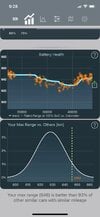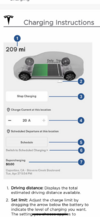I have a Feb 2023 MSLR, it's 16 months old with 10,300 miles. I started using the Tessie app to track battery degredation 6 months after buying the car. The first charge show 3.5% degredation with 92.9kWh usable capacity. I was charging to 89% at home. Degredation and capacity went to 4.6% and 91.9 kWh 6 months later this past February. So I ran an experiment the last 4 months gradually lowering max charge from 89% to 55%. Once during that time the max was set back to 89% fir a trip. The degradation has lowered to 3.5% and capacity raised to 92.6 kWh. It's just interesting and I really don't know if it real. I only have Tessie numbers.


Welcome to Tesla Motors Club
Discuss Tesla's Model S, Model 3, Model X, Model Y, Cybertruck, Roadster and More.
Register
Install the app
How to install the app on iOS
You can install our site as a web app on your iOS device by utilizing the Add to Home Screen feature in Safari. Please see this thread for more details on this.
Note: This feature may not be available in some browsers.
-
Want to remove ads? Register an account and login to see fewer ads, and become a Supporting Member to remove almost all ads.
You are using an out of date browser. It may not display this or other websites correctly.
You should upgrade or use an alternative browser.
You should upgrade or use an alternative browser.
Battery Degredation Lessens With Lower SOC
- Thread starter zoomer0056
- Start date
lithium ion batteries have a well documented recovery effect that means that the battery can recover a little capacity by using low SOC and cycle at low SOC.So I ran an experiment the last 4 months gradually lowering max charge from 89% to 55%. Once during that time the max was set back to 89% fir a trip. The degradation has lowered to 3.5% and capacity raised to 92.6 kWh. It's just interesting and I really don't know if it real. I only have Tessie numbers.
Its not easy to set a number for the amount of recovery.
Its clear that the most part of lost capacity never comes back.
Its also clear that cycling at low SOC with small cycles recovers some lithium from fast charging (lithium plating that resolves/reverts to cyclable lithium) so when they perform research with cyclic tests and the stop the cycle for measuring of the present capacity, if they do low SOC cycles the battery recovers lost capacity.
Heres a test of actual tesla model S cells, taken from a 6 month old Tesla model S.
50-80-100% follows other research result on the spot.
But 20% is much less than it “should be”
(20 and 50% is very close in all other cyclic tests)
Why did 20% show lower calendar aging than the first thought expectation?
Well, the cells comes from a actual Tesla model S, used for 6 months. How do we think that car was charged (about 2018) ?
Well it is a good chance it was charged daily to 80-90% (as most do, and did back then).
The battery was (most probably) charged as most people do and the cells put to calendar aging test at 20% actually recovered about as much as the calendar aging caused degradation, so the end result is close to 0%.
The 50% at 25C is also less than expected, probably the same thing we see there.
So, yes when lowering the SOC we expect to see a lower degradation and in some cases even notice the recovery.
I see the nominal full pack decreases slightly when doing multiple large cycles, I also see the NFP climb when doing cycles at low SOC after the large cycles. Today I’m positive that it is the MS seeing the recovery. Its even so at it WILL climb if i do 20-30% DoD from 55-35/25% but it might stay on spot if I charge to 55% but only use a few percent each day.
Well jeeze Louise, too late now to correct it to Feb 2022.You lost me at a 2023 that’s 16 months old.
Last edited:
I've read about this before but was skeptical. The recovery on my Feb 2022 car was small but definite. It was also interesting to see charging once to 89% for a trip did not show up as a degredation spike. So, 55% day to day and higher for day trips.So, yes when lowering the SOC we expect to see a lower degradation and in some cases even notice the recovery.
Proppilot
Member
I have a 2021 (September) MSLR and with close to 50,000 kM have less than 2% range loss. My range started at (about) 650 kilometres. At 25,000 kilometres I started to experience significant range loss (see attached) that by 40,000 kilometres was down to about 630 kilometres (average) but you can see where the individual plots were and as low as 620 kilometres. That was with charging up to 80% SOC. At 40,000 and I am not sure exactly what happened, the 'recommended' max SOC on the screen went from 80% to 90% and I started charging to 90% SOC. Every few weeks I run down to 10-20% SOC and back to 100% SOC to recalibrate the BMS and the result is what I have attached.
Attachments
Very interesting and the battery capacity went up. Do you think the recommended charge limit changed due to a software upgrade. Or maybe the battery was being monitored which triggered the change. Where on the screen is the recommended charge limit?At 40,000 and I am not sure exactly what happened, the 'recommended' max SOC on the screen went from 80% to 90% and I started charging to 90% SOC.
Proppilot
Member
I am quite sure it went from 80-90 the upgrade before last. Do a few cycles down to 10% then charge to 100% to recalibrate your battery management system
As far as Im concerned, I have ever only seen 50-90% and below 90% from Tesla.
50-90 was introduced when they changed from two fixed settings to the 50-90 slider.
The text has been below 90% as long ad I have had a Tesla?
50-90 was introduced when they changed from two fixed settings to the 50-90 slider.
The text has been below 90% as long ad I have had a Tesla?
That battery visualization was replaced with a slider. It's easier to see the Tesla recommended daily charge between 50% and 90%. The upper trip limit means feel free to use the whole battery for a long trip. The lower daily slider recommendation tells me that Tesla is aware of battery chemistry for longevity. As far as I know though, Tesla has never weighed in on battery health outright.As far as Im concerned, I have ever only seen 50-90% and below 90% from Tesla.
50-90 was introduced when they changed from two fixed settings to the 50-90 slider.
The text has been below 90% as long ad I have had a Tesla?
That battery visualization was replaced with a slider. It's easier to see the Tesla recommended daily charge between 50% and 90%. The upper trip limit means feel free to use the whole battery for a long trip. The lower daily slider recommendation tells me that Tesla is aware of battery chemistry for longevity. As far as I know though, Tesla has never weighed in on battery health outright.View attachment 946018
Yes, it was the @Proppilots post I was thinking about. I’ve never seen any facts for 80% being recommended. I’ve sure heard the ”80%” , at least five times each time I visit *any* forum though.
and I am not sure exactly what happened, the 'recommended' max SOC on the screen went from 80% to 90% and I started charging to 90% SOC.
My guess is that the recommended always was ”50-90%” or ”Below 90%” sincew the slider was invented, long time ago.
(This doesn not mean that @Proppilot did not increase the setting to 90% and saw a increased range. Its probable that the BMS was helped but the real capacity of the battery did probably not change).
Proppilot
Member
For sure, the range for ‘trip’ was originally 80-100 % and that changed to 90-100% sometime earlier this year. The range in the chart I attached is the calculated full range after charging regardless of what level one charges to. It is extrapolated to 100%Yes, it was the @Proppilots post I was thinking about. I’ve never seen any facts for 80% being recommended. I’ve sure heard the ”80%” , at least five times each time I visit *any* forum though.
My guess is that the recommended always was ”50-90%” or ”Below 90%” sincew the slider was invented, long time ago.
(This doesn not mean that @Proppilot did not increase the setting to 90% and saw a increased range. Its probable that the BMS was helped but the real capacity of the battery did probably not change).
I concur, I don’t think the actual battery chemistry changed. I believe perhaps the BMS calculation became more accurate when I started charging to 90% or Tesla made some calculation improvements in some recent software for the MSLR.
The chart speaks for itself. Each of those data points is estimated full charge range regardless of percentage charged to. I pulled the attachment from the 2021 manual and if you look at the gradients on the graph, you can see that TRIP is 80-100%
Attachments
Last edited:
ucmndd
Well-Known Member
There was no change. “Daily” has always been 50-90%. “Trip” has always been 90-100%.For sure, the range for ‘trip’ was originally 80-100 % and that changed to 90-100% sometime earlier this year.
The change in recommendation you’re referring to never happened. 80% was never a thing.
cmaster
Member
I have a 2024 model that 18 months old! I am with ya!You lost me at a 2023 that’s 16 months old.
Refer to post #24, I mean #4.I have a 2024 model that 18 months old! I am with ya!
Cheburashka
Active Member
I usually charged to 50-60% and the car showed a lot of degradation but charging to 100% a few times gave me back 10 miles. I guess the BMS was able to calibrate for the battery capacity.
Point is, that the range display isn't an entirely accurate measure of battery health when we are talking about a delta of 5-10% or less.
Point is, that the range display isn't an entirely accurate measure of battery health when we are talking about a delta of 5-10% or less.
Similar threads
- Replies
- 45
- Views
- 6K
- Replies
- 5
- Views
- 2K
- Replies
- 26
- Views
- 1K
- Replies
- 20
- Views
- 4K




